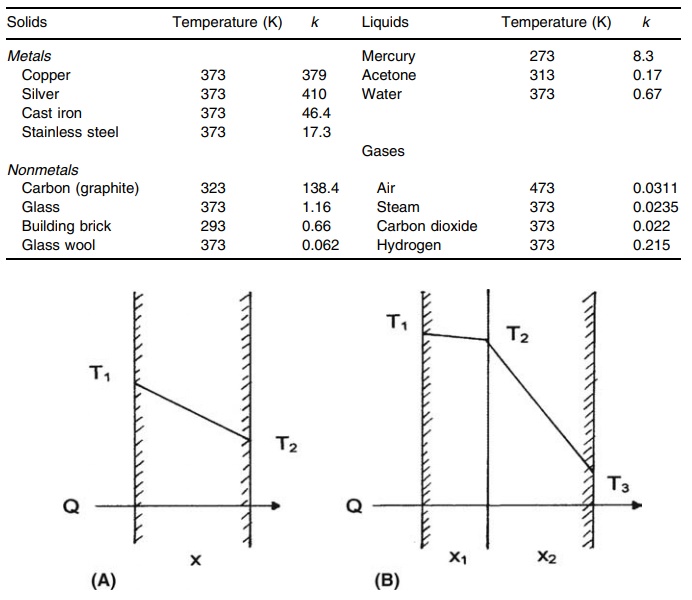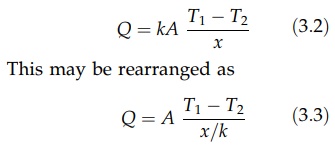Heat Transfer Through a Wall
| Home | | Pharmaceutical Technology |Chapter: Pharmaceutical Engineering: Heat Transfer
Heat transfer by conduction through walls follows the basic relation given by Fourier’s equation in which the rate of heat flow, Q, is proportional to the temperature gradient, dT/dx, and to the area normal to the heat flow, A.
HEAT TRANSFER THROUGH A WALL
Heat
transfer by conduction through walls follows the basic relation given by
Fourier’s equation in which the rate of heat flow, Q, is proportional to the
temperature gradient, dT/dx, and to
the area normal to the heat flow, A.

As
the distance, x, increases, the
temperature, T, decreases. Hence,
measuring in the x direction, the
temperature gradient, dT/dx, is
algebraically nega-tive. The proportionality constant, k, is the thermal conductivity. Its numerical value depends on the
material of which the body is made and on its temperature.
Values
of thermal conductivity, k, for a
number of materials are given in Table 3.1.
Metals
have high conductivity, although values vary widely. The non-metallic solids
normally have lower conductivities than metals. For the porous materials of
this group, the overall conductivity lies between that of the homogeneous solid
and the air that permeates the structure. Low resultant values lead to their
wide use as heat insulators. Carbon is an exception among nonmetals. Its
relatively high conductivity and chemical inertness permit its wide use in heat
exchangers.
TABLE 3.1 Thermal Conductivity, k, of
Various Materials (in J/sec m K)

FIGURE 3.1 Conduction of heat through a
wall.
Steady
nondirectional heat transfer through a plane wall of thickness x and area A is
represented in Figure 3.1A. Assuming that the thermal conductivity does not
change with temperature, the temperature gradient will be linear and equal to
(T1 T2)/x,
where T1 is the temperature of the hot face and T2 is the
temperature of the cool face. Equation (3.1) then becomes

where
x/k is the thermal resistance. Thus,
for a given heat flow, a large temperature drop must be created if the wall or
layer has a high thermal resistance.
An
increase in thermal resistance will reduce the heat flow promoted by a given
temperature difference. This is the principle of insulation by lagging, and it
is illustrated by a composite wall shown in Figure 3.1B. The rate of heat
transfer will be the same for both materials if steady-state heat transfer
exists. Therefore,

The
major temperature drop occurs across the distance x2 since this material provides the major thermal
resistance. (In the case of heavily lagged, thin metal walls, the temperature
drop and thermal resistance of the metal are so small that they can be
ignored.) Rearrangement of this equation and the elimi-nation of the junction
temperature give

Equations
of this form can be applied to any number of layers.
Related Topics
